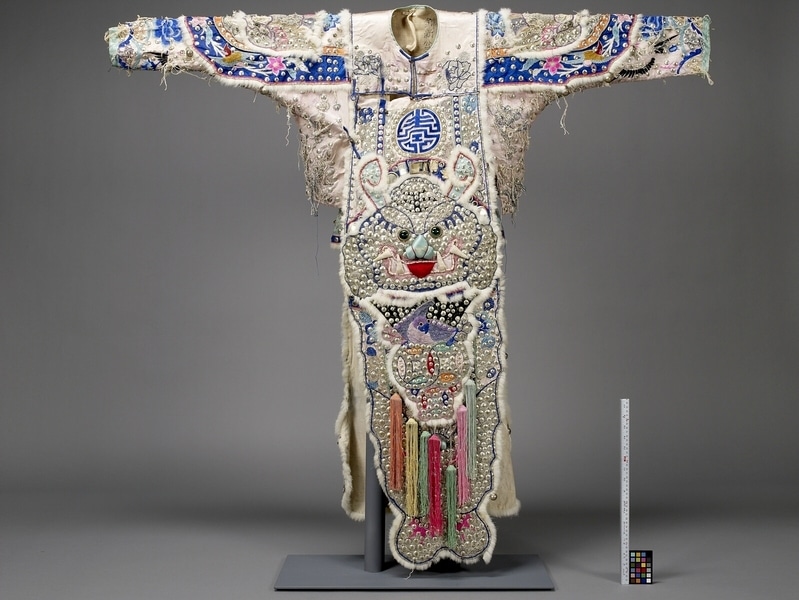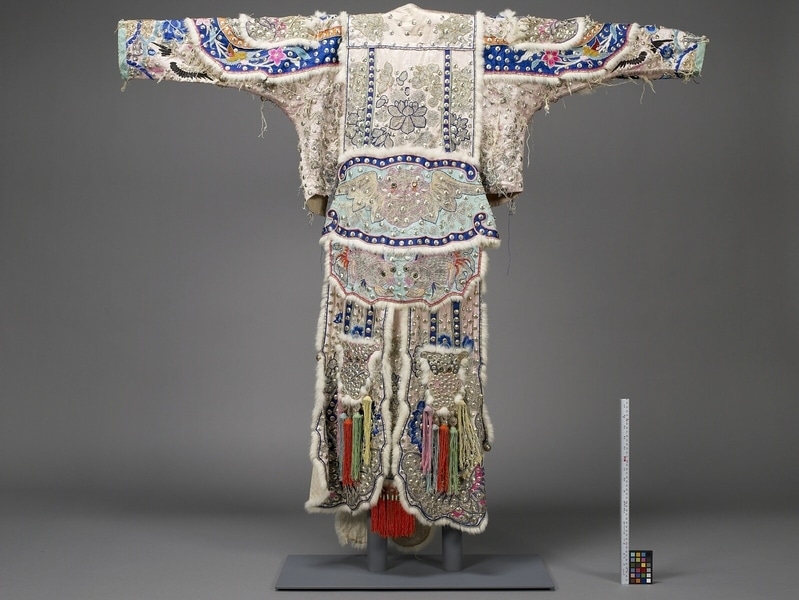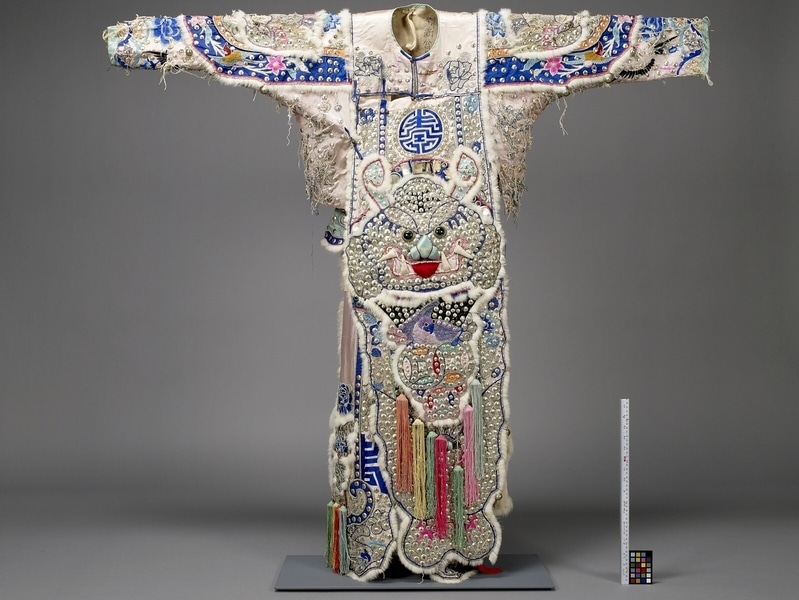Cantonese Opera Armour Item Number: N1.685 a from the MOA: University of British Columbia



Description
Mauve armour robe with slender sleeves, epaulets and a side opening with brass frog fasteners. Below the waist, the armour divides into one front panel and three back panels. On the front are fu dog, butterfly, bird, peony and triple cash motifs in silver, red, purple, blue and green on a mauve ground. The collar band has peony motifs in silver, yellow and blue on a mauve ground. The sleeves have multicoloured bird, narcissus and peony motifs. On the back are butterfly, bat, fish, lotus and peony motifs. On each of the large back panels there are five tassels in yellow, turquoise, pink, green and orange. On the front are seven tassels in turquoise, green, orange, yellow, light and dark pink. There are green glass eyes, tin reflectors, bells and white fur on the front and back. The inside lining is natural-coloured linen. (The couching has all fallen apart along the sides.)
History Of Use
Cantonese opera costume, worn by warrior.
Cultural Context
theatre
Specific Techniques
All seams are enclosed. All stitching that can be seen is hand-sewn. Cotton lining is pasted to outer layer. Wear on other costumes made of similar fabric suggests that it is silk warp with cotton weft, or vice-versa. Embroidered sections are done with long satin stitches.
Iconographic Meaning
The narrow sleeves indicate that this costume is for a military role rather than a civil role. The round disk represents a mirror that served to deflect evil forces.
Narrative
A large group of Cantonese opera costumes, musical instruments, props, trunks, and stage fittings was left with the Jin Wah Sing Musical Association, apparently by some of the many itinerant troupes visiting Vancouver to perform in the Chinatown theatres in the pre World War II period. There is no certain knowledge of why these materials were not taken back to China by them. They were used by the Jin Wah Sing Musical Association in their performances until they became too dated. The association continued to preserve them carefully, storing them in their headquarters and in the basement of the Chinese Freemasons building until several groups of materials were sold and donated to the Museum of Anthropology.
Item History
- Made by Gam San Gung Si (Manufacturer) in Guangzhou, Guangdong, China ? during 1925
- Collected in Vancouver, British Columbia, Canada
- Owned by Jin Wah Sing Musical Association before August 28, 1973
- Received from Barrett Montford Endowment Fund (Funding source), Jin Wah Sing Musical Association (Seller), Leon & Thea Koerner Foundation (Funding source), Museum of Anthropology Donations Fund (Funding source), Mah Society of North America (Funding source), Canada-China Friendship Association (Funding source), Quon H. Wong Agencies (Funding source) and Edith Low-Beer (Funding source) on August 28, 1973
What
- Name
- Cantonese Opera Armour
- Identification Number
- N1.685 a
- Type of Item
- armour
- Material
- silk fibre, cotton fibre, rabbit skin, glass, brass metal, paste adhesive, paper, silver metal, gold metal and dye
- Manufacturing Technique
- woven, dyed, sewn, embroidered, appliqued, padded, stiffened, glued and couched
- Overall
- height 136.0 cm, width 147.0 cm
Who
- Culture
- Chinese: Cantonese
- Creator
- Gam San Gung Si (Manufacturer)
- Previous Owner
- Jin Wah Sing Musical Association
- Received from
- Barrett Montford Endowment Fund (Funding source), Jin Wah Sing Musical Association (Seller), Leon & Thea Koerner Foundation (Funding source), Museum of Anthropology Donations Fund (Funding source), Mah Society of North America (Funding source), Canada-China Friendship Association (Funding source), Quon H. Wong Agencies (Funding source) and Edith Low-Beer (Funding source)
Where
- Holding Institution
- MOA: University of British Columbia
- Made in
- Guangzhou, Guangdong, China ?
- Collected in
- Vancouver, British Columbia, Canada
When
- Creation Date
- during 1925
- Ownership Date
- before August 28, 1973
- Acquisition Date
- on August 28, 1973
Other
- Item Classes
- textiles
- Condition
- poor
- Accession Number
- 0248/0070 a